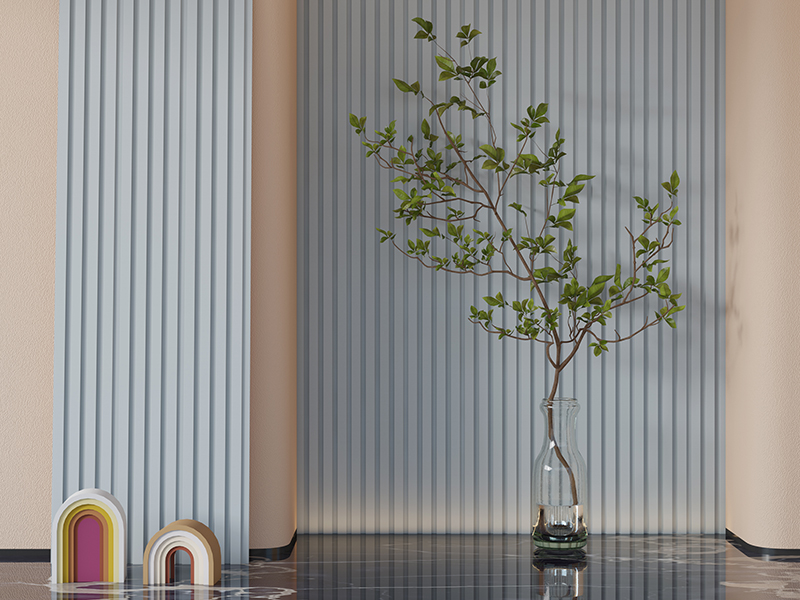Wood-Plastic Composite (WPC) materials have gained popularity in various construction applications due to their unique combination of wood fibers and thermoplastic polymers. Among the WPC products, the 152 MM WPC wall fluted panel is frequently utilized as a cladding material for both interior and exterior walls. In this analysis, we will delve into the key aspects of durability and longevity concerning this particular wall fluted panel and compare it with alternative materials to provide a comprehensive understanding of its performance.
Durability:
Resistance to Moisture and Rot:
The 152 MM WPC wall fluted panel demonstrates excellent resistance to moisture, making it an ideal choice for areas exposed to humidity, rain, or other wet conditions. Unlike traditional wood, it does not absorb water significantly, preventing rot, warping, or swelling. Furthermore, the plastic component in WPC acts as a barrier against fungal decay, ensuring that the panel retains its structural integrity over time.
Insect Resistance:
The combination of wood fibers and plastic in WPC renders it less appealing to insects, such as termites or wood borers, compared to natural wood panels. This inherent resistance is particularly beneficial in areas where termite infestations are common, significantly extending the lifespan of the wall fluted panel.
Impact Resistance:
The 152 MM WPC wall fluted panel demonstrates remarkable impact resistance, making it suitable for high-traffic areas or regions prone to extreme weather conditions. Its ability to withstand impacts without cracking or splintering contributes to its overall durability.
UV Stability:
UV radiation can lead to the degradation of materials, resulting in fading, discoloration, and reduced structural integrity. The 152 MM WPC wall fluted panel typically contains additives that enhance its UV stability, enabling it to maintain its original appearance and physical properties for an extended period, even when exposed to harsh sunlight.
Dimensional Stability:
WPC panels have better dimensional stability than natural wood, as the thermoplastic component minimizes expansion and contraction in response to temperature and humidity fluctuations. This property ensures that the wall fluted panel maintains its shape and size over time, reducing the risk of warping or buckling.
Longevity:
Lifespan:
The 152 MM WPC wall fluted panel is known for its relatively long lifespan, which can exceed that of traditional wood panels. Proper installation and maintenance can further extend its life, making it a cost-effective choice in the long run.
Low Maintenance:
Unlike some alternative cladding materials, WPC requires minimal maintenance throughout its life. Regular cleaning with mild soap and water is usually sufficient to keep the panel in good condition. This low maintenance requirement contributes to its longevity, as it minimizes the risk of premature deterioration.
Environmental Factors:
The WPC wall fluted panel's longevity is influenced by various environmental factors, such as exposure to moisture, temperature extremes, and pollution levels. However, with its inherent resistance to moisture, rot, and insects, the panel's durability is preserved, resulting in an extended lifespan in diverse environmental conditions.
Comparison with Alternative Materials:
WPC vs. Natural Wood:
Compared to natural wood, the
152 MM WPC wall fluted panel outperforms in terms of durability and longevity. While wood may require regular treatments, such as staining or sealing, to enhance its resistance to moisture and pests, WPC inherently possesses these properties. Additionally, WPC's resistance to rot and decay makes it more durable in the long term, reducing the need for frequent replacements.
WPC vs. PVC Panels:
Polyvinyl chloride (PVC) panels are another common alternative for wall cladding. While PVC exhibits excellent moisture resistance, it can be susceptible to UV degradation over time. In contrast, WPC's combination of wood fibers and plastic offers superior UV stability, contributing to its extended lifespan and color retention.
WPC vs. Fiber Cement Panels:
Fiber cement panels are known for their durability and fire resistance. However, they can be heavy and brittle, making installation more challenging. WPC, being lighter and more impact-resistant, offers easier handling during installation while maintaining satisfactory fire resistance properties.
The 152 MM WPC wall fluted panel proves to be a durable and long-lasting cladding material due to its inherent resistance to moisture, rot, insects, and impact. Its UV stability and dimensional stability further contribute to its extended lifespan. Compared to alternative materials like natural wood, PVC, and fiber cement panels, WPC emerges as a favorable choice for various construction applications, offering a balance between performance and cost-effectiveness. Nonetheless, like any material, proper installation and maintenance are crucial to maximize its durability and longevity.

